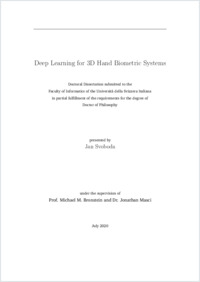Deep learning for 3D hand biometric systems
- Svoboda, Jan
- Bronstein, Michael (Degree supervisor)
- Masci, Jonathan (Degree committee member)
-
18.05.2020
142 p
Thèse de doctorat: Università della Svizzera italiana, 2020
Deep learning
Computer vision
Convolutional neural network
Geometric deep learning
Graph neural network
Biometrics
Hand biometrics
Hand geometry
3D hand
Biometric system
Fingerprint
Palmprint
Hand dataset
English
Hands are an indispensable part of human bodies used in our everyday life to express ourselves and manipulate the surrounding world. Moreover, a hand contains highly- unique characteristics that allow for distinguishing among different individuals. Though fingerprints are widely-known for this, the hand also has a unique geometric shape, palmprint, and vein structure. The shapes of a hand and its parts have been studied as biometric identifiers in the past, yielding state-of-the-art approaches in the field of Biometrics; however, these are limited in their practicality. This thesis aims at overcoming the limitations and improving the performance of hand-shape-based biometric systems, taking advantage of the latest developments in Deep Learning and 3D Sensing. In particular, such systems can be improved either by means of biometric fusion or by working directly with the hand shape. Biometric fusion allows for improvement in hand- shape-based biometric systems by simultaneously utilizing other modalities such as palmprints or fingerprints. To this end, we propose novel deep-learning based approaches to contact-free palmprint and fingerprint recognition. These improvements achieve state-of-the-art results on multiple standard benchmarks in both palmprint recognition and in processing latent fingerprint impressions. Additionally, current 3D- sensing technologies provide low-cost sensors that allow us to capture the surface of the hand as a 3D point cloud. This type of data is often noisy but can be dealt with by employing recent deep-learning architectures designed for point clouds. We base our solution on state-of-the-art geometric deep learning architectures, extending them with a novel clustering layer. We show how to train an optimal representation of a noisy 3D point cloud of a human hand purely from synthetic data. For evaluation, we collect a brand-new dataset of human hand videos in RGB-D, named NNHand RGB-D. Extensive evaluation of our approach on our dataset unveils the viable potential of low-precision, hand-shape-based biometric systems.
- Language
-
- English
- Classification
- Computer science and technology
- License
-
License undefined
- Identifiers
-
- RERO DOC 328794
- URN urn:nbn:ch:rero-006-119819
- ARK ark:/12658/srd1319370
- Persistent URL
- https://n2t.net/ark:/12658/srd1319370
Statistics
Document views: 416
File downloads:
- Texte intégral: 652
